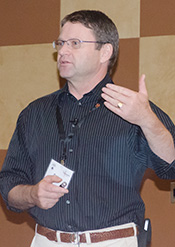Good News:
They're All Carriers of Something
by Kasey Brown, associate editor, Angus Journal®
OKLAHOMA CITY, Okla. (June 14, 2013) — One can choose to look at a glass as being half full or half empty. Dorian Garrick, Iowa State University animal scientist and Jay Lush Endowed Chair in Animal Breeding and Genetics, said he believes broken genes in beef cattle can be a glass half full. Broken genes provide information, and with this information comes more options, he explained to attendees of the 45th Annual Beef Improvement Federation Research Symposium and Convention in Oklahoma City June 12-15.

Dorian Garrick
Right now, the list of known genetic defects is appallingly short, he said. The fact that chromosomes occur in pairs means that an individual inherits two copies of every gene, one from each parent — except for some genes on the sex chromosomes. A mutation in one copy of the gene may not be very serious as long as the other copy is functional. If the mutation is on a sex chromosome, that’s when mutations appear in progeny, and it’s often how mutations are discovered.
Some mutations result by a “stop” sequence in the genetic code occurring too soon. The gene becomes dysfunctional, or “broken.” This is known as a loss-of-function mutation. However, these can generally be found with a 50K high-density genomic test. As long as carriers of these broken genes aren’t bred to each other (avoiding inbreeding), these loss-of-function genes aren’t a real issue, Garrick said.
His tips to commercial producers to manage this genetic variation was to
- crossbreed, because different breeds likely have different mutations;
- outbreed, by avoiding sons of herd sires; or
- put up with it and submit DNA samples on suspicious animals.
He advised seedstock producers to change the “shoot, shovel and shut up” mentality. Submit DNA samples on suspicious deaths. Using SNP genotyping on all prospective herd sires, and preferably all breeding stock, and using DNA testing for known defects will also help. Garrich said culling all carrier parents, especially on outstanding animals, is not needed. Instead of culling, he suggested selecting clean offspring for subsequent use.
In summary, Garrick emphasized selection and culling should be aimed at increasing the frequency of favorable alleles and reducing the frequency of unfavorable alleles.
Return to the Newsroom for links to the PowerPoint presentation that accompanied this presentation.
-----------------------------------------Editor’s Note: This summary was written under contract or by staff of Angus Productions Inc. (API). Through an agreement with the Beef Improvement Federation, we are encouraging reprinting of the articles to those who will adhere to the reprint guidelines available on this site. Please review those guidelines or contact Shauna Rose Hermel, editor, at 816-383-5270. PowerPoints are posted with permission of the presenter and may not be reproduced in whole or in part without the express permission of the presenter.
API's coverage of the event is made possible through collaboration with BIF and sponsorship of LiveAuctions.tv. For questions about this site, or to notify us of broken links, click here.
Headquartered in Saint Joseph, Mo., API publishes the Angus Journal, the Angus Beef Bulletin, the Angus Beef Bulletin EXTRA, and the Angus Journal Daily, as well as providing online coverage of events and topics pertinent to cattlemen through the Angus Journal Virtual Library.



